Municipalities of Belgium

 |
|---|
|
|
Belgium comprises 581 municipalities (Dutch: gemeenten; French: communes; German: Gemeinden), 300 of them grouped into five provinces in Flanders and 262 others in five provinces in Wallonia, while the remaining 19 are in the Brussels Capital Region, which is not divided in provinces. In most cases, the municipalities are the smallest administrative subdivisions of Belgium, but in municipalities with more than 100,000 inhabitants, on the initiative of the local council, sub-municipal administrative entities with elected councils may be created. As such, only Antwerp, having over 500,000 inhabitants, became subdivided into nine districts (Dutch: districten). The Belgian arrondissements (Dutch: arrondissementen; French: arrondissements; German: Bezirke), an administrative level between province (or the capital region) and municipality, or the lowest judicial level, are in English sometimes called districts as well.
Lists of municipalities
Here are three lists of municipalities for each one of the three regions:
- List of municipalities of the Brussels-Capital Region (19 municipalities)
- List of municipalities of the Flemish Region (300 municipalities)
- List of municipalities in Wallonia (262 municipalities)
History
Before 1830
This section needs expansion. You can help by adding to it. (June 2008) |
The municipalities, as an
Not much changed during the United Kingdom of the Netherlands, only a number of smaller municipalities were merged.
Between 1830 and 1961
In 1831, Belgium was divided into 2,739 municipalities, a number which remained more or less constant until 1961. The number of municipalities was reduced to 2,508 when the Belgian borders were recognised in 1839, as 124 municipalities were ceded to the
From 1961 to 1977
In 1961, the so-called
Article 4 of the
Lucien Harmegnies, Minister of the Interior in the government of Gaston Eyskens (1968–1972) decided to continue the process of territorial reorganization of Belgium. In 1971, the provisions of the Unity Law were extended and modified to apply to large agglomerations, which were initially excluded from its provisions. It was another Minister of the Interior, Joseph Michel, who managed the process. On 30 December 1975 the law regarding the merger of the municipalities was adopted. The merger became effective on 1 January 1977. The merger of 1977 further reduced the number of municipalities in Belgium from 2,359 to 596.
Antwerp
Because of the specific nature of the reorganization in
21st century
The fifth state reform (2001) transferred the responsibility over municipalities from the federal level to the three regions.
This did not instantly have any significant effect on the reorganisation of municipalities, up until the Flemish Bourgeois Government (2014-2019) provided a legal framework and financial incentives for municipalities to consider merging. This led 15 Flemish municipalities to merge into seven, decreasing the total number of Flemish municipalities from 308 to 300. Their municipal councils were elected in the regular elections of 14 October 2018, and the change took effect on 1 January 2019.
Municipal organization
Mayor
The mayor (
In the Flanders and Brussels, the mayor is appointed by the regional government, on the nomination of the municipal council, for a term of office of six years. In Wallonia, the mayor is the municipal councillor who received the largest number of preferential votes of the majority party that received the largest number of votes in the municipal elections. Hence, it is also possible that the mayor is not a member of the largest party, as the largest party is not always part of the governing coalition. It is also possible in Wallonia for the municipal council to adopt a constructive motion of no confidence in the municipal college.
College
The executive organ of the municipality is known as the college of mayor and aldermen (Dutch: college van burgemeester en schepenen; French: collège des bourgmestre et échevins), commonly referred to as the college of aldermen (Dutch: schepencollege; French: collège échevinal), in Flanders and Brussels, and as the municipal college (French: collège communal; German: gemeindekollegium) in Wallonia. This college is responsible for the daily administration of the municipality. It is also responsible for the preparation and implementation of the decisions of the municipal council.
Council
The municipal council (Dutch: gemeenteraad; French: conseil communal; German: Gemeinderat) is the representative assembly of the municipality and consists of members directly elected for a term of office of six years. The number of municipal councillors depends on the number of inhabitants of the municipality, and can vary from 7 to 55. It is responsible for all matters that are of municipal interest.
Differences between the Regions
This section needs expansion. You can help by adding to it. (June 2008) |
Following the
The three Regions can amend or replace the existing legislation on the municipalities, most notably the New Municipal Law. In the Flanders the Municipal Decree of 15 July 2005 applies. In Wallonia the Code of Local Democracy and Decentralization applies. In Brussels several provisions of the New Municipal Law have been modified by ordinance, such as the Ordinance of 17 July 2003. The legal framework in the three Regions is still relatively similar, but that could change in the future.
Agglomerations and federations
This section needs expansion. You can help by adding to it. (June 2008) |
Since 1970, the
See also
- Communities, regions and language areas of Belgium
- List of Belgian municipalities by population
- List of cities in Belgium
- Municipalities with language facilities
- Provinces of Belgium
- Public Centre for Social Welfare (CPAS, OCMW)
References
- ^ Smeets, Rudi (2006-08-18). "Herstappe – Vijftig procent inwoners gaat mee naar Brussel" (in Dutch). Het Nieuwsblad, newspaper. Retrieved 2007-09-04.
External links
- Vereniging van Vlaamse Steden en Gemeenten – Association of Flemish Cities and Municipalities
- Union des Villes et Communes de Wallonie – Union of Cities and Municipalities of Wallonia
- AVCB-VSGB – Association of the City and Municipalities of the Brussels-Capital Region
